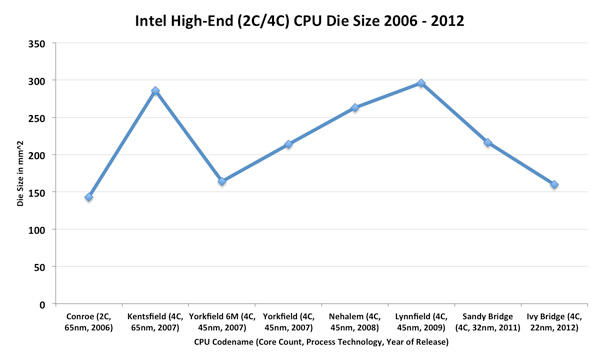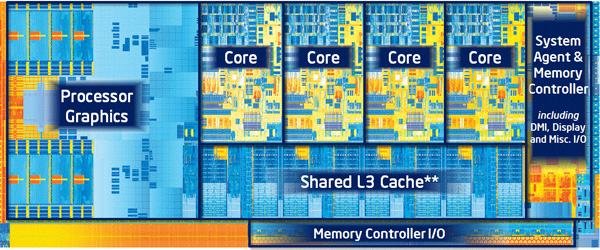The Intel Ivy Bridge (Core i7 3770K) Review
by Anand Lal Shimpi & Ryan Smith on April 23, 2012 12:03 PM EST- Posted in
- CPUs
- Intel
- Ivy Bridge
Die Size and Transistor Count
At IDF last year we got word of Ivy Bridge's transistor count (1.4 billion), however today we know its die size: 160mm2. That's 75% the size of a quad-core Sandy Bridge, but with 20% more transistors.
This marks the first time since 2006 that Intel is offering a high-end desktop CPU with this small of a die size. I'm excluding the 6-core parts from the discussion since that line isn't really aimed at the same market anymore. The chart is even more insane when you consider the Ivy Bridge die size includes an integrated GPU alongside four of the highest performance x86 cores Intel has ever shipped. Remove the GPU and Ivy Bridge is even smaller than Conroe. A hypothetical GPU-less Ivy Bridge would measure in at roughly 113mm^2 chip on its 22nm process, making it smaller than any high-end Intel CPU since the days of the Pentium 3.
| CPU Specification Comparison | ||||||||
| CPU | Manufacturing Process | Cores | Transistor Count | Die Size | ||||
| AMD Bulldozer 8C | 32nm | 8 | 1.2B | 315mm2 | ||||
| Intel Ivy Bridge 4C | 22nm | 4 | 1.4B | 160mm2 | ||||
| Intel Sandy Bridge E (6C) | 32nm | 6 | 2.27B | 435mm2 | ||||
| Intel Sandy Bridge E (4C) | 32nm | 4 | 1.27B | 294mm2 | ||||
| Intel Sandy Bridge 4C | 32nm | 4 | 1.16B | 216mm2 | ||||
| Intel Lynnfield 4C | 45nm | 4 | 774M | 296mm2 | ||||
| Intel Sandy Bridge 2C (GT1) | 32nm | 2 | 504M | 131mm2 | ||||
| Intel Sandy Bridge 2C (GT2) | 32nm | 2 | 624M | 149mm2 | ||||
Ivy Bridge is tiny—but what does this mean? For starters, it means the obvious—Intel has little competition in the desktop space. I'm always hard on AMD in my meetings with them because of this reason alone. A less than competitive AMD means we get a less aggressive Intel.
More importantly however, a tiny Ivy means that Intel could have given us a much bigger GPU without breaking the bank. I hinted at this possibility in our Ivy Bridge architecture article. Unfortunately at the time only Apple was interested in a hypothetical Ivy Bridge GT3 and rumor has it that Otellini wasn't willing to make a part that only one OEM would buy in large quantities. We will eventually get the GPU that Apple wanted, but it'll be next year, with Haswell GT3. And the GPU that Apple really really wanted? That'll be GT4, with Broadwell in 2014.
All of this being said however, we must keep in mind that Ivy Bridge is both faster than Sandy Bridge and no more expensive. If we look at the supply and pricing constraints that accompany TSMC's 28nm process, the fact that Intel is able to ramp up 22nm and ship the first products without any price increase is something we shouldn't take for granted.












173 Comments
View All Comments
Tujan - Tuesday, April 24, 2012 - link
cause how I see it :" If you're constantly transcoding movies to get them onto your smartphone or tablet, you need Ivy Bridge. In less than 7 minutes, and with no impact to CPU usage, I was able to transcode a complete 130 minute 1080p video to an iPad friendly format—that's over 15x real time."
The majority of trancoding is going the other way- from an ipad friendly format to another friendly type format (device or not). Cell phone to pc,ipad to youtube etc.
I like the concept of the transcode,encode,but as much as with the bandwidth necesary to utilize them they are as they are 'bandwidth hungry'. And here is the first I have noticed that of telling there is hardware to facilitate the h.264 type encoding. "Hardware" to do this.
The screens from all of those cell phones in high resolution 'still'require bandwidth to utilize them. .. and so on.
I dont understand it completely but I'll attempt to stay tuned.
androticus - Tuesday, April 24, 2012 - link
I find this review enormously confusing. You mix IB and SB parts/sku's throughout, without clearly highlighting which is which. On page 2, at first I thought the chart was of IB CPUs, but then realized it was a mishmash of both. Likewise on all the benchmark charts, and I couldn't even distinguish various SB/IB/core counts apart.Was this article written solely for people who have a PhD in Intel sku's ???
Dudenell - Tuesday, April 24, 2012 - link
Could we actually see comparison with the i7-920 or i7-950 in there?Pjotr - Wednesday, April 25, 2012 - link
Thanks for the Compile test, this is all I look at to decide purchases at work.sld - Wednesday, April 25, 2012 - link
The A8 is conspicuously missing from the 2 charts showing idle and load system consumption. Why is this so?greggm2000 - Wednesday, April 25, 2012 - link
Anand/Ryan,According to the article linked below from today, it seems that Intel may be using TIM paste instead of fluxless solder in the IB chips, and if so, does this seem like a reasonable explanation for the high temperatures that people are seeing?
I'm interested in your thoughts on this... and if it's true, and if the article is correct, then Intel deliberately handicapping their chips (to possibly preserve SB-E sales?) is quite troubling to me.
http://www.overclockers.com/ivy-bridge-temperature...
slickr - Thursday, April 26, 2012 - link
Hi, is this good enough of an upgrade over a Pentium 4 for office, internet and movies?And will the HD4000 beat a ATI x1650XT?
Death666Angel - Friday, April 27, 2012 - link
Hey guys!Good review overall, thanks for that!
But the Quicksync section was kinda strange. No way that an x86 software solution generates worse IQ than any accelerated stuff. Unless you were comparing IQ with settings that have the x86 do recode the file in the same time it takes the other solutions. Anyway, I don't understand what you did in that section. :-)
kevith - Friday, April 27, 2012 - link
Great review.Would it be interesting to see how it fared in a series 6 motherboard, now that it actually is backwards compatible?
pwnsweet - Saturday, April 28, 2012 - link
The only thing I care about is how much faster this new slab of silicon will power though my x264 encoding and that's the one part of the review that was left out!Why anand, why!?